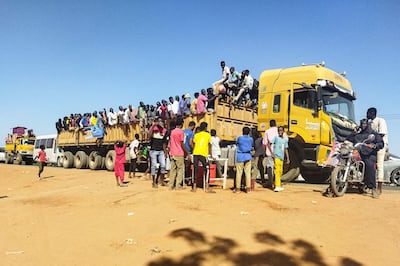Reports that Iran has supplied Sudan’s army with combat drones could fuel the civil war in the Afro-Arab nation and betray an apparent attempt by Tehran to expand its influence in the Red Sea at a time of growing tension over the strategic waterway, analysts told The National.
If confirmed, the shipment, they say, would represent another troubling sign that the chaos and violence is attracting external players and undermining the chances of the war in Sudan ending soon.
"It’s a case of Iran projecting power and influence that is likely to trouble and possibly cause discomfort to regional supporters of the Sudanese armed forces,” Michael Hanna, a senior Middle East expert with the International Crisis Group, told The National.
The analysts say reports of Iran shipping drones to the Sudanese army have been circulating for about a week in capital cities in the region and the West.
“The conflict is now much more intractable,” Mr Hanna said from New York.
Jaafar Mansour, a retired Sudanese army general, told The National a shipment of the drones could be a case of Tehran honouring a deal arranged shortly before the war broke out last April.
“it’s a win-win situation for both," he said of the unconfirmed reports. "The army desperately needs weapons and Iran is happy to oblige in return for facilities on the Red Sea."
The Sudanese army and the rival paramilitary Rapid Support Forces have been locked in a war that has displaced more than 7 million people and pushed about half the country’s population to the brink of hunger.
The warring parties – led by army chief Gen Abdel Fattah Al Burhan and his former ally RSF commander Gen Mohamed Dagalo – have shown no signs of engaging in sincere efforts to end the nine-month conflict, with the pair seemingly determined to secure victory in the battlefield.
A series of truces mediated by the US and Saudi Arabia in the early days of the war never took hold, with both sides breaching conditions soon after they came into force.

The RSF, which stemmed from a notorious, Darfur-based militia called the Janjaweed, has been gaining the upper hand in the ruinous conflict that began in Khartoum, spread to western regions and more recently reached Al Jazeera region, the country’s breadbasket, south of the capital.
The army has been relying heavily on air power but to little avail. It has failed to dislodge fighters from Khartoum – most of which is controlled by the RSF – or beat them out of a string of cities and towns the paramilitary has seized in the west and south.
A Bloomberg report, citing western officials and satellite images, said Sudan had received shipments of the Iranian Mohajer-6, a single-engine unmanned aircraft manufactured by Quds Air Industries that carries precision-guided munitions.
The Mohajer-6 is known to be capable of air-to-surface attacks and electronic warfare.

Analysts who examined satellite imagery confirmed the drone’s presence in Sudan, it was reported, but it was not established how many were received. Both warring parties have been using drones.
The National could not independently verify the reports. Calls to the Sudanese military spokesman’s office were unanswered.
Sudan cut diplomatic relations with Iran in 2016 after the storming of the Saudi embassy in Tehran. In October, the two countries agreed to restore diplomatic ties, a decision that followed a meeting between their foreign ministers and, significantly, was made while the Afro-Arab nation was at war.
“The shipment of drones is an attempt by Iran to gain a foothold in the middle reaches of the Red Sea,” said Osman Al Mirghani, a prominent Sudanese analyst. “They already have a foothold in the south of the Red Sea through the Houthis in Yemen.”
The Houthis have been targeting ships transiting the Red Sea, actions the movement’s leaders say are meant to support the Palestinians in Gaza, the tiny coastal enclave devastated by an Israeli onslaught in response to a deadly attack by Hamas – also backed by Iran – in southern Israel on October 7.
Sudan’s Red Sea coastline runs for about 800km and shipping lanes in the waterway are known to be much closer to the its western shores than to its east.
Mr Al Mirghani, however, warned that allowing Iran to gain influence in Sudan would likely jeopardise the support the army enjoys from regional powers, particularly Egypt, the country’s powerful neighbour to the north.
“Egypt becomes alarmed at the slightest hint of foreign presence in Sudan. But for Iran, influence there gives it a strategic window into eastern and central Africa.”
The US has previously accused Iran of providing the Mohajer-6 drones to Russia in the war in Ukraine.
Washington last year expanded its Iran-related sanctions, citing Tehran’s “continued, deliberate proliferation of drones enabling Russia, its proxies in the Middle East and other destabilising actors”.
Iran says its defence exports have risen in recent years. However, it has repeatedly denied sending drones to Russia and said Ukraine has no evidence to support the claim.
Al Shafie Ahmed contributed to this report from Kampala, Uganda







